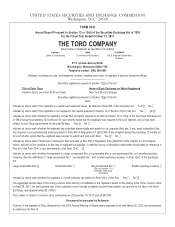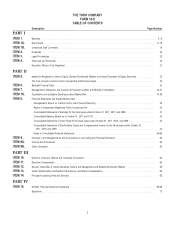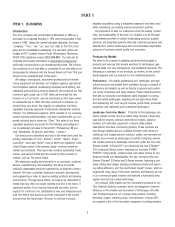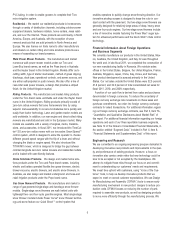Toro 2011 Annual Report Download - page 17
Download and view the complete annual report
Please find page 17 of the 2011 Toro annual report below. You can navigate through the pages in the report by either clicking on the pages listed below, or by using the keyword search tool below to find specific information within the annual report.snow fall accumulations may result in lower winter season reve-
ITEM 1A.RISK FACTORS
nues for landscape contractor professionals, causing such custom-
ers to forego or postpone spring purchases of our mowing prod-
The following are significant factors known to us that could materi-
ucts. To the extent that unfavorable weather conditions are
ally adversely affect our business, operating results, financial con-
exacerbated by global climate change or otherwise, our sales and
dition, or future financial performance.
other operating results may be affected to a greater degree than
If economic conditions and outlook in the United States we have previously experienced.
and in the other countries in which we conduct business
Increases in the cost, or disruption in the availability, of
do not improve or if they worsen, our net sales and
raw materials and components that we purchase and/or
earnings could be adversely affected.
increases in our other costs of doing business, such as
Demand for our products depends upon economic conditions and transportation costs, may adversely affect our profit
outlook in the U.S. and in the other countries in which we conduct margins and businesses.
business, which include but are not limited to recessionary condi-
We purchase raw materials such as steel, aluminum, fuel, petro-
tions; slow or negative economic growth rates; the impact of state
leum-based resins, linerboard, and other commodities, and compo-
debt and sovereign debt defaults by certain European countries;
nents, such as engines, transmissions, transaxles, hydraulics, and
slow down or reductions in levels of golf course development, ren-
electric motors, for use in our products. In addition, we are a pur-
ovation, and improvement; golf course closures; continuation of
chaser of components and parts containing various commodities,
reduced levels of home ownership, construction, and sales; home
including steel, aluminum, copper, lead, rubber, and others that are
foreclosures; negative consumer confidence; reduced consumer
integrated into our end products. To the extent that commodity
spending levels; prolonged high unemployment rates; higher com-
prices increase and we do not have firm pricing from our suppliers,
modity and components costs and fuel prices; inflationary or defla-
or our suppliers are not able to honor such prices, increases in the
tionary pressures; reduced credit availability or unfavorable credit
cost of such raw materials and components and parts may
terms for our distributors, dealers, and end-user customers; higher
adversely affect our profit margins if we are unable to pass along
short-term, mortgage, and other interest rates; and general eco-
to our customers these cost increases in the form of price
nomic and political conditions and expectations. In the past, some
increases or otherwise reduce our cost of goods sold. Historically,
of these factors have caused our distributors, dealers, and
we have engaged in proactive vendor negotiations, used alternate
end-user customers to reduce spending and delay or forego
sourcing options, substituted materials, engaged in internal cost
purchases of our products, which has had an adverse effect on our
reduction efforts, and introduced moderate price increases on
net sales and earnings. If economic conditions and outlook in the
some of our products to offset a portion of increased raw material,
U.S., Europe, and in the other countries in which we conduct busi-
component, and other costs. However, we may not be able to fully
ness do not improve, or if they worsen, our net sales and earnings
offset such increased costs in the future. Further, if our price
could be adversely affected in the future.
increases are not accepted by our customers and the market, our
Weather conditions may reduce demand for some of our net sales, profit margins, earnings, and market share could be
products and adversely affect our net sales or otherwise adversely affected. Increases in our other costs of doing business
adversely affect our operating results. may also adversely affect our profit margins and business. For
example, an increase in fuel costs may result in an increase in our
From time to time, weather conditions in a particular geographic transportation costs, which also could adversely affect our operat-
region may adversely affect sales and field inventory levels of ing results and business. Although most of the raw materials and
some of our products. For example, in the past, drought conditions components used in our products are generally commercially avail-
have had an adverse effect on sales of certain mowing equipment able from a number of sources and in adequate supply, certain
products, unusually rainy weather or severe drought conditions that components are sourced from single suppliers. Any disruption in
result in watering bans have had an adverse effect on sales of our the availability of such raw materials and components from our
irrigation products, and lower snow fall accumulations in key mar- suppliers, our inability to timely or otherwise obtain substitutes for
kets have had an adverse effect on sales of our snow thrower such items, or any deterioration in our relationships with or the
products. Similarly, adverse weather conditions in one season may financial viability of our suppliers could adversely affect our
adversely affect customer purchasing patterns and our net sales business.
for some of our products in another season. For example, lower
11
























